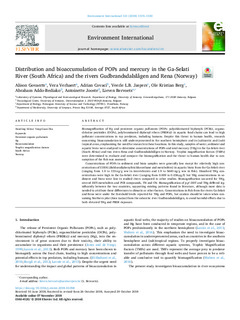| dc.contributor.author | Govaerts, Alison | |
| dc.contributor.author | Vera, Verhaert | |
| dc.contributor.author | Covaci, Adrian | |
| dc.contributor.author | Jaspers, Veerle | |
| dc.contributor.author | Berg, Ole Kristian | |
| dc.contributor.author | Addo-Bediako, Abraham | |
| dc.contributor.author | Jooste, Antoinette | |
| dc.contributor.author | Bervoets, Lieven | |
| dc.date.accessioned | 2019-03-29T08:12:04Z | |
| dc.date.available | 2019-03-29T08:12:04Z | |
| dc.date.created | 2019-01-09T20:27:34Z | |
| dc.date.issued | 2018 | |
| dc.identifier.citation | Environment International. 2018, 121 1319-1330. | nb_NO |
| dc.identifier.issn | 0160-4120 | |
| dc.identifier.uri | http://hdl.handle.net/11250/2592323 | |
| dc.description.abstract | Biomagnification of Hg and persistent organic pollutants (POPs: polychlorinated biphenyls (PCBs), organochlorine pesticides (OCPs), polybrominated diphenyl ethers (PBDEs)) in aquatic food chains can lead to high pollutant concentrations in top predators, including humans. Despite this threat to human health, research concerning bioaccumulation is still underrepresented in the southern hemisphere and in (sub)arctic and (sub)tropical areas, emphasizing the need for research in these locations. In this study, samples of water, sediment and aquatic biota were analyzed to determine concentrations of POPs and total mercury (THg) in the Ga-Selati river (South Africa) and two rivers Rena and Gudbrandsdalslågen in Norway. Trophic magnification factors (TMFs) were determined to evaluate and compare the biomagnification and the threat to human health due to consumption of the fish was assessed.
Concentrations of POPs in sediment and biota samples were generally low except for relatively high concentrations of ∑DDX (dichlorodiphenyltrichloroethane and metabolites) in aquatic biota from the Ga-Selati river (ranging from 1.9 to 133 ng/g ww in invertebrates and 1.9 to 5643 ng/g ww in fish). Dissolved THg concentrations were high in the Ga-Selati river (ranging from 0.009 to 0.036 μg/l) but THg concentrations in sediment and biota were low in studied rivers compared to other studies. Biomagnification occurred for THg, several DDT-metabolites and PCB compounds, TN and CN. Biomagnification of p,p′-DDT and THg differed significantly between the two countries, supporting existing patterns found in literature, although more data is needed to attribute these differences to climatic or other factors. Concentrations in fish from the rivers Ga-Selati and Rena were under the threshold levels reported for THg and POPs, but caution should be taken when consuming Northern pike (Esox Lucius) from the subarctic river Gudbrandsdalslågen, to avoid harmful effects due to both elevated THg and PBDE exposure. | nb_NO |
| dc.language.iso | eng | nb_NO |
| dc.publisher | Elsevier | nb_NO |
| dc.rights | Attribution-NonCommercial-NoDerivatives 4.0 Internasjonal | * |
| dc.rights.uri | http://creativecommons.org/licenses/by-nc-nd/4.0/deed.no | * |
| dc.title | Distribution and bioaccumulation of POPs and mercury in the Ga-Selati River (South Africa) and the rivers Gudbrandsdalslågen and Rena (Norway) | nb_NO |
| dc.type | Journal article | nb_NO |
| dc.type | Peer reviewed | nb_NO |
| dc.description.version | publishedVersion | nb_NO |
| dc.source.pagenumber | 1319-1330 | nb_NO |
| dc.source.volume | 121 | nb_NO |
| dc.source.journal | Environment International | nb_NO |
| dc.identifier.doi | https://doi.org/10.1016/j.envint.2018.10.058 | |
| dc.identifier.cristin | 1653638 | |
| dc.description.localcode | © 2018. Made available under the CC-BY-NC-ND 4.0 license http://creativecommons.org/licenses/by-nc-nd/4.0/ | nb_NO |
| cristin.unitcode | 194,66,10,0 | |
| cristin.unitname | Institutt for biologi | |
| cristin.ispublished | true | |
| cristin.fulltext | postprint | |
| cristin.qualitycode | 1 | |

